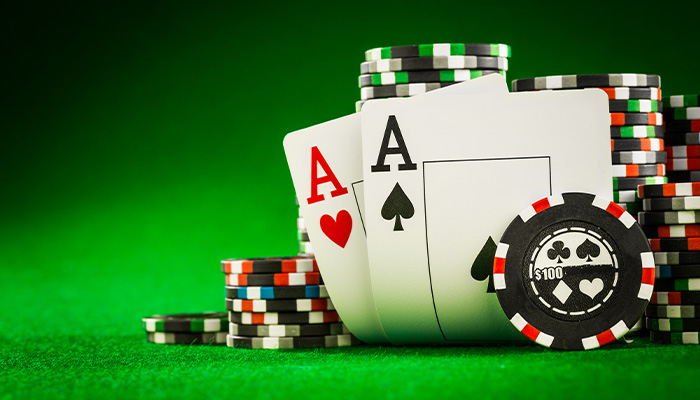A Complete Guide to Poker Chips
 Guide to Poker Chips
Guide to Poker Chips
- Choosing the Best Poker Chips for Your Home
- Poker Chips Set: How to Choose for Different Games
- How to Assign Value to Your Poker Chips
- Maintaining Your Poker Chips
- Spotting Counterfeit Poker Chips
- The Evolution of Poker Chips
- Frequently Asked Questions
Today, we’re going to be talking all about poker chips – the unsung heroes of every poker game. Whether you’re a casual player looking for a nice set of chips for poker nights, or a professional wanting an expensive collector’s piece, this guide will show you all you need to know about buying and looking after poker chips. We’ll help you choose the best ones for your games, look at how to assign values to your chips, and much more. Let’s get started!
Choosing the Best Poker Chips for Your Home
Regardless of whether you play Five Card Draw Poker or any other variation, the best poker chips can be a game-changer for your casino nights. The weight, texture, and design can drastically enhance the gaming experience for all the players involved.
But how do you select the best poker chips? What should you consider when buying a poker chip set? How do you assign value to your chips? If you’re looking for answers to any of these questions, then you’ve come to the right place. In today’s post, we’ll answer these questions and give you all the information you need to make informed decisions when buying chips.
Poker is quickly gaining popularity in the US, especially in states where it’s now legal. If you’re looking for online poker in Pennsylvania, make sure you check out our list of recommended poker websites, all of which have been hand-picked by our team of online gambling experts.
Poker Chips Set: How to Choose for Different Games
When selecting a poker chips set, several factors come into play. First and foremost, consider the type of poker game you play most frequently. For example, if you’re playing tournaments with re-buy options, you’ll need to have more casino chips than if you’re playing small cash games with a few friends.
If you don’t yet know what type of poker games you’ll be playing, it’s best to overestimate rather than underestimate. A basic set of poker chips usually includes around 300 chips, enough for 5-6 players. If you often host larger games, consider a set with 500 or even 1,000 chips.
Once you’ve decided on the rough number of chips you need, it’s time to decide on the material. Plastic chips are lightweight and affordable, making them a good choice for beginners or casual games.
However, if you want to create more of a casino-like atmosphere, consider spending a bit more on clay or metal chips. These professional casino chips are much more like the ones you play with in a land-based casino, and they have that satisfying weightiness when you pick them up.
It’s also really important to look at whether the chips come with pre-printed denominations on them. Cheaper sets often do, which can be helpful for beginners. However, experienced players often prefer chips without denominations as it gives them more control to assign their own values to the chips. Chips without pre-printed denominations also lend themselves more to tournament play.
A final thing to consider is the case holding the chips. If you buy an expensive set of professional casino chips, they’ll usually come in a sturdy, leather case, making it easy to travel with. However, cheaper sets often come in simple plastic – so keep this in mind.
If you’re looking for people to play against, why not had online? Just make sure you play at one of the best online poker sites to ensure you’re treated fairly.
How to Assign Value to Your Poker Chips
If your poker chips already come with values assigned to them, you can skip past this step. However, if you’ve purchased blank chips, you may be wondering what exactly to do with them, and how to assign the correct values to them. Believe it or not, this is actually much harder than it may seem, and you’ll need to take a number of factors into account.
In low-stakes home games, it’s common to assign the white chip as the lowest value one, followed by red, blue, and then green or black as the highest.
Remember, the goal is to have enough chips of each denomination to allow the game to run smoothly, without you running out of chips too early. You’ll usually find this requires you to have a lot more lower-value chips, as they’re used more frequently.
Thankfully, one of the best things about playing poker at home is that if you do run out of chips, you can quite easily swap-out the high value chips for simple slips of paper, or even coins.
Maintaining Your Poker Chips
Taking good care of your poker chips is important if you want them to last a long time, and this is especially relevant if you’ve spent a lot of money buying the best poker chips you could find.
You should clean your chips frequently, being careful not to use strong chemicals or rough tools that could damage the surface of the chips. We recommend cleaning them gently using a soft cloth or a gentle brush, some mild soap, and warm water. This will get rid of any dirt or grime without you having to worry about damaging them.
It’s also important to think about how you’re going to store your chips. When they’re not being played with, you should try to keep them in a case or a chip carrier to protect them from dust, moisture, and being dropped on the floor. If you’re planning to store them for a long time, make sure to find a cool and dry place away from direct sunlight so the colors don’t fade.
It’s also good to be mindful of how you use the chips when you’re playing with them. If you’re playing with a few friends for a low amount of money, and will probably be getting tipsy, it’s best to avoid high-end chips, as it’s likely they’ll end up on the floor at some point! In higher-stakes settings, try not to drop them, step on them, or stack them too high, as this could end up chipping or cracking the chips.
Spotting Counterfeit Poker Chips
Counterfeit poker chips are a real concern, especially for collectors or those spending a lot of money on high-end chips. One of the key things to look for when buying chips is consistency. If you notice inconsistencies in the color, weight, or design of the chips, there’s a good chance they could be counterfeit. Genuine chips have a specific weight – usually between 8.5 and 10.6 grams – and all chips in a set will weigh the same.
Another good method of spotting counterfeit chips is to look at the edges. Authentic poker chips are usually sharper and more defined, whereas counterfeit chips tend to have softer, rounded edges. The sound of the chip can also provide information on their authenticity. For example, genuine clay chips have a distinctive ‘clink’ when they hit each other, while counterfeit chips often produce a pretty low, dull sound.
If you’re buying high-end chips, you can also consider using a UV or black light. The most expensive professional poker chips in the world often have certain markings or inks that only show up under this type of light, although we should note this is only for collectors; you don’t need to worry about this unless you’re spending thousands of dollars.
The Evolution of Poker Chips
Poker chips have a fascinating history, with the earliest poker games using gold nuggets and coins. Chips have since evolved, and today are available in a wide variety of colors, sizes, and materials.
Before conventional poker chips were invented, players would place their bets using pretty much anything that had some value. As noted, in the very early days – we’re talking the 1800s here – players would use gold nuggets, coins, and even gold dust to place their bets. As you can imagine, this wasn’t without its challenges. It was also difficult to accurately compare the value of different “chips”, leading to frequent disputes and confusion.
This led to the introduction of standardized betting tokens, often made from bone, wood, or ivory. However, these were easy to forge, so, by the late 1800s, poker rooms and gambling establishments in the US began to create clay chips, marking the beginning of the modern era of poker chips as we know them today.
Today, chips are typically made of plastic or a clay composite and are available in an array of colors, designs, and denominations. In the past, chip sets were made of ivory, but this is now illegal in most countries, and it’s heavily frowned upon for collectors to have ivory chip sets. Below, we’ve included an interesting table looking at some of the key differences between modern poker chips and those from the past:
| Early Poker Chips | Modern Poker Chips |
|---|---|
| Made from gold, bone, wood, ivory | Made from plastic, clay composite |
| Difficult to standardize | Standard weights, colors, sizes |
| Easy to forge | Difficult to forge |
| Basic designs | Wide range of designs and customization |
| Mainly used in establishments | Widely used in homes and casinos |




